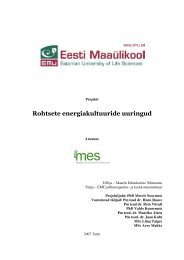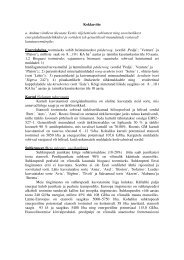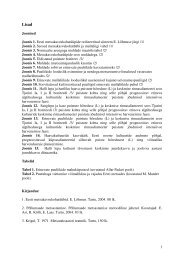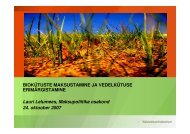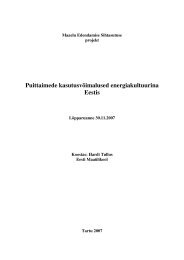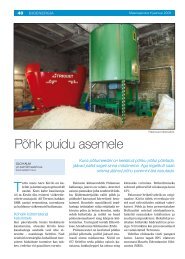Põllumajandusministeeriumi ja Maaelu ... - bioenergybaltic
Põllumajandusministeeriumi ja Maaelu ... - bioenergybaltic
Põllumajandusministeeriumi ja Maaelu ... - bioenergybaltic
You also want an ePaper? Increase the reach of your titles
YUMPU automatically turns print PDFs into web optimized ePapers that Google loves.
The studies on the use of boilers, their technical state and investment needs carried out after<br />
2000 show that in average the boilers installed in Estonian boiler plants are either underloaded<br />
or in reserve. Over 60% of the total capacity of boilers run on liquid fuel, natural gas or coal is<br />
not actively used. From the total capacity of wood and peat fired boilers 30% is estimated not<br />
to be in active use.<br />
Since the mandatory purchase price for renewable electricity has risen to 115 Estonian sents<br />
per kWh according to the Electricity Market Act, feasibility of the designed biomass based<br />
CHP plants has improved significantly. In the feasibility analysis the average prices for<br />
Estonia in July 2007 for bulk woodchips 127 EEK per cubic meter (169 EEK/MWh), heat<br />
selling price to network 450 EEK/MWh th , electricity selling price 1150 EEK/MWh el and<br />
annual utization time 6000 h/a were taken for the basis. The analysis allowed drawing the<br />
following conclusions:<br />
• building of a CHP plant with 17 MW el and 40 MW th (and higher) capacity using the<br />
steam cycle is economically feasible and relatively risk free investment in case of the<br />
possible rise of fuel price;<br />
• building of a CHP plant with 3.5 MW el and 16 MW th capacity using the steam cycle is<br />
economically feasible, but still a risk related business. A 30% rise in fuel prices or<br />
decrease in the plant load would make the feasibility of the project problematic;<br />
• small CHP plants using the steam cycle may be feasible only in special cases, for<br />
example in case of subsidized investments, available uniform heat load throughout a<br />
year or guaranteed options for purchasing inexpensive fuel. One of the reasons for the<br />
modest feasibility of small CHP plants using the steam cycle is also the low heat and<br />
power ratio (10 – 20%, in special cases up to 25%).<br />
Today several large CHP plants are under construction or are being designed at Väo, Tartu and<br />
Ahtme. When the construction of all these plants is completed and in addition to wood fuels<br />
also peat is used, in Estonia the need for wood fuels in energy production would still grow<br />
64% altogether compared to the demand in 2006. There is no such an amount of fuel available<br />
in the market now and it could be supplied only when the logging residues were more widely<br />
utilized while the 30% price rise should be taken into account. The rise in fuel prices and<br />
difficulties with supply may end with the bankruptcy or at least economic difficulties of<br />
several small wood fuel fired boiler plants.<br />
The main barrier for building CHP plants is the low level of heat load in summer. The loads<br />
appropriate for building the plant are available only in large DH systems (Tallinn, Tartu,<br />
Kohtla-Järve, Narva, and some other cities). However, building of a biofuel based CHP plant<br />
in the Kohtla-Järve region (Ahtme) is still unlikely, because then the reasonable use of gas<br />
generated by the shale oil production would become complicated. At the same time Eesti<br />
Energia is designing the 10% use of biofuels in the 11 th unit of Balti Power Plant. In several<br />
locations, if CHP plants were built, they would remain without sufficient load.<br />
Building of new biofuel fired boiler plants may be economically feasible when the number of<br />
in-service nominal load hours is sufficiently high – at least 5000 h/a. Considering the fairly<br />
low load and technical level of existing boilers, it would be reasonable to renovate a part of<br />
these boilers and provide higher load for these boilers. The present coal fired boilers should<br />
be replaced with modern combustion equipment burning other fuels. Considering the low unit<br />
capacity and location of coal boilers, one of the alternatives could be replacing them with<br />
pellet boilers. For all biofuel related projects it is indispensable to prepare a profound business<br />
plan which should include an analysis of loads and load curves, also potentials for the fuel<br />
supply as well as an analysis of economic risks.<br />
99




